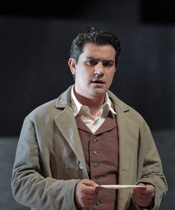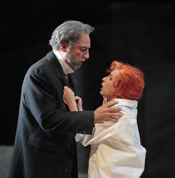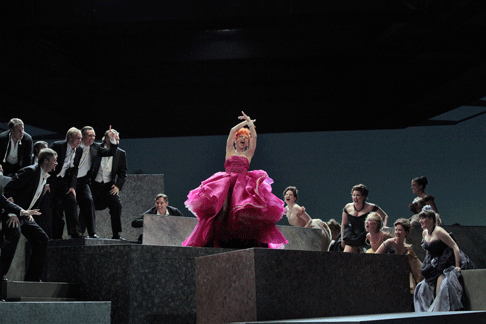Recently in Reviews
English Touring Opera are delighted to announce a season of lyric monodramas to tour nationally from October to December. The season features music for solo singer and piano by Argento, Britten, Tippett and Shostakovich with a bold and inventive approach to making opera during social distancing.
This tenth of ten Live from London concerts was in fact a recorded live performance from California. It was no less enjoyable for that, and it was also uplifting to learn that this wasn’t in fact the ‘last’ LfL event that we will be able to enjoy, courtesy of VOCES8 and their fellow vocal ensembles (more below …).
Ever since Wigmore Hall announced their superb series of autumn concerts, all streamed live and available free of charge, I’d been looking forward to this song recital by Ian Bostridge and Imogen Cooper.
The Sixteen continues its exploration of Henry Purcell’s Welcome Songs for Charles II. As with Robert King’s pioneering Purcell series begun over thirty years ago for Hyperion, Harry Christophers is recording two Welcome Songs per disc.
Although Stile Antico’s programme article for their Live from London recital introduced their selection from the many treasures of the English Renaissance in the context of the theological debates and upheavals of the Tudor and Elizabethan years, their performance was more evocative of private chamber music than of public liturgy.
In February this year, Albanian soprano Ermonela Jaho made a highly lauded debut recital at Wigmore Hall - a concert which both celebrated Opera Rara’s 50th anniversary and honoured the career of the Italian soprano Rosina Storchio (1872-1945), the star of verismo who created the title roles in Leoncavallo’s La bohème and Zazà, Mascagni’s Lodoletta and Puccini’s Madama Butterfly.
Evidently, face masks don’t stifle appreciative “Bravo!”s. And, reducing audience numbers doesn’t lower the volume of such acclamations. For, the audience at Wigmore Hall gave soprano Elizabeth Llewellyn and pianist Simon Lepper a greatly deserved warm reception and hearty response following this lunchtime recital of late-Romantic song.
Collapsology. Or, perhaps we should use the French word ‘Collapsologie’ because this is a transdisciplinary idea pretty much advocated by a series of French theorists - and apparently, mostly French theorists. It in essence focuses on the imminent collapse of modern society and all its layers - a series of escalating crises on a global scale: environmental, economic, geopolitical, governmental; the list is extensive.
For this week’s Live from London vocal recital we moved from the home of VOCES8, St Anne and St Agnes in the City of London, to Kings Place, where The Sixteen - who have been associate artists at the venue for some time - presented a programme of music and words bound together by the theme of ‘reflection’.
'Such is your divine Disposation that both you excellently understand, and royally entertaine the Exercise of Musicke.’
Amongst an avalanche of new Mahler recordings appearing at the moment (Das Lied von der Erde seems to be the most favoured, with three) this 1991 Mahler Second from the 2nd Kassel MahlerFest is one of the more interesting releases.
‘And there was war in heaven: Michael and his angels fought against the dragon; and the dragon fought and his angels, And prevailed not; neither was their place found any more in heaven … that old serpent … Satan, which deceiveth the whole world: he was cast out into the earth, and his angels were cast out with him.’
If there is one myth, it seems believed by some people today, that probably needs shattering it is that post-war recordings or performances of Wagner operas were always of exceptional quality. This 1949 Hamburg Tristan und Isolde is one of those recordings - though quite who is to blame for its many problems takes quite some unearthing.
There was never any doubt that the fifth of the twelve Met Stars Live in Concert broadcasts was going to be a palpably intense and vivid event, as well as a musically stunning and theatrically enervating experience.
‘Love’ was the theme for this Live from London performance by Apollo5. Given the complexity and diversity of that human emotion, and Apollo5’s reputation for versatility and diverse repertoire, ranging from Renaissance choral music to jazz, from contemporary classical works to popular song, it was no surprise that their programme spanned 500 years and several musical styles.
The Academy of St Martin in the Fields have titled their autumn series of eight concerts - which are taking place at 5pm and 7.30pm on two Saturdays each month at their home venue in Trafalgar Square, and being filmed for streaming the following Thursday - ‘re:connect’.
The London Symphony Orchestra opened their Autumn 2020 season with a homage to Oliver Knussen, who died at the age of 66 in July 2018. The programme traced a national musical lineage through the twentieth century, from Britten to Knussen, on to Mark-Anthony Turnage, and entwining the LSO and Rattle too.
With the Live from London digital vocal festival entering the second half of the series, the festival’s host, VOCES8, returned to their home at St Annes and St Agnes in the City of London to present a sequence of ‘Choral Dances’ - vocal music inspired by dance, embracing diverse genres from the Renaissance madrigal to swing jazz.
Just a few unison string wriggles from the opening of Mozart’s overture to Le nozze di Figaro are enough to make any opera-lover perch on the edge of their seat, in excited anticipation of the drama in music to come, so there could be no other curtain-raiser for this Gala Concert at the Royal Opera House, the latest instalment from ‘their House’ to ‘our houses’.
"Before the ending of the day, creator of all things, we pray that, with your accustomed mercy, you may watch over us."
Reviews
![Natalie Dessay as Violetta [Photo by Ken Howard courtesy of Santa Fe Opera]](http://www.operatoday.com/_MG_4060a.gif)
27 Jul 2009
An Evening at Père Lachaise [Or, Natalie Dessay Attempts Violetta]
A fine-sounding Santa Fe Opera orchestra, excellently conducted by Frédéric
Chaslin, was barely into the haunting, delicate prelude to Act I of La
traviata, when a funeral procession, wet umbrellas unfurled, arrived to
wend its way though a stage full of big grey marble rectangular boxes,
handsomely abstracted tomb shapes, soon to be the courtesan Violetta
Valéry’s destination. So much for the Prelude to Act I.
 Saimir Pirgu (Alfredo)
Saimir Pirgu (Alfredo)
During the intensely dramatic prelude to Act IV, anonymous stage figures in
half light, darted about draping the tombs with white shrouds preparing the
death scene of Violetta — so much for that essential orchestral moment;
again our attention had fled. For Flora Bervoix’s Act III party, the
weighty boxes, artfully arranged at varying heights, served as pedestals to
show off swaying party girls in lavish 20th century dancing gowns.
“Dancing on her grave?” Santa Fe’s new mounting of
Verdi’s opera, largely the work of a director Laurent Pelly’s
French team and the prima donna Natalie Dessay, seemed an evening at Père
Lachaise, almost literally, but Lachaise-manqué, transmogrified. The conceit
was interesting; many in the audience liked it and enjoyed its innovative
energy, yet it was, as we say, for its own sake — it added no new insight
into the old opera. It could also get in the way.
 Laurent Naouri (Germont) & Natalie Dessay (Violetta)
Laurent Naouri (Germont) & Natalie Dessay (Violetta)
Opinion divides on Mme. Dessay, as it usually will when coloraturas essay
Violetta’s essentially dramatic role. Through history, light-voiced divas
such as Galli-Curci, Lily Pons and Roberta Peters have tried and faded with the
fatal part. Deconstructively ruinous at Santa Fe was Dessay’s Act II
costume — dull, shapeless cotton slacks and a large man’s-style
white overshirt; barefoot. She was a 1960s hippie caught at home. The problem
was it robbed her of much dignity: and Violetta’s self-denying dignity is
key to the effect of this central act, with the two Germont men, each asking
her something different, and opposing. She is cruelly torn; it takes all her
resources to survive intact. By dressing her way down for the big confrontation
scenes, Dessay’s Violetta lost a lot of feminine stature and,
unintentionally I am sure, pushed her comic-seeming side; she looked raffish
and moved in an almost Carol Burnett way — all wrong. Producer Pelly got
this act badly off key. To do anything to defeminize Violetta is a grave
mistake. Violetta must be poignantly believable in Act II — or her show
does not fly, hélas!
The device of the graveyard underlying the whole opera seemed an over-kill,
ultimately a kind of director’s bad joke. Once again, where was dignity,
seriousness? La traviata is a mid-19th century tragic opera, with many
social overtones; it is most certainly to be taken seriously. But I did not
sense a lot of that with M. Pelly, though the performing artists worked hard.
Where was letting the music speak for itself (as in the two preludes mentioned
above)? Is it anything less than an affront to second-guess Giuseppe Verdi in
judging the effect of his music, and what it takes to put it over in theatrical
terms? Opera lovers will have their own views on this. In an interesting touch,
Père Germont was costumed and played as a 19th century figure, and that he
surely is; but Violetta is no less so, and to take her out of that cultural
milieu was counterproductive.
 Natalie Dessay (Violetta)
Natalie Dessay (Violetta)
Finally, Mme. Dessay is not a Violetta. As seen on the Santa Fe
stage, she is a little bird — in Act I a frantic, drunken little bird
with an orange wig and bright red and pink plumage; by the end she was a
plucked pullet flopping about the stage. Her voice does not have the dynamic or
tonal range to explore the full dimensions of Verdi’s music or
Violetta’s emotions; it is almost always the same color. She was wise to
sing both stanzas of “Addio del passato…” for a soft
pianissimo tone is her best asset just now, and she long held the aria’s
final p. high-A. A singular moment. I like Mme. Dessay a lot, and she’s
had a wonderful career, especially considering two throat surgeries and a
baritone husband. I think she has the spunk, but ultimately not enough vocal
resource to do justice to Verdi’s paragon soprano role. The surprise of
the evening was the excellence of Parisian baritone Laurent Naouri in the role
of Père Germont. His well-voiced traditional portrayal played strongly against
the eccentricity of the rest of the production; he showed vividly how this
wonderful opera should be treated. The young Alfredo was debut artist Saimir
Pirgu, an Albanian tenor with a pleasing voice and manner, graced by a nice
smile. In the latter stages of the opera he warmed to some beautiful soft-toned
singing.
J. A. Van Sant ©2009
![Natalie Dessay as Violetta [Photo by Ken Howard courtesy of Santa Fe Opera]](http://www.operatoday.com/_MG_4060a.gif)


